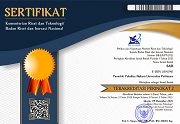Maritime Dispute Resolution With Mediation Techniques
 )
)
(1) Faculty of Law Bhayangkara Jakarta Raya University, Jakarta, Indonesia
 Corresponding Author
Corresponding Author
Abstract
Introduction: In resolving ordinary maritime disputes related to national borders, from several types of dispute resolution, mediation is the right way to resolve disputes involving third parties.
Purposes of the Research: This paper aims to find out that in resolving martim aurann disputes the law is contained in international law, namely UNCLOS 1982 which regulates martim disputes.
Methods of the Research: The type of research is normative juridical with analysis using legal documents in the form of primary legal materials, secondary legal materials, and tertiary legal materials.
Results of the Research: Alternative settlement of territorial boundary disputes can be done by, first, referring to UNCLOS 1982 through Bilateral Mutual Agreement in drawing a temporary line (equidistant line) using the equity principle and considering relevant factors and the possibility of modifying the equidistant line with the diplomatic approach of both countries, second, through the ASEAN mechanism, and. third, through the mechanism of the International Court of justice by promoting equitable principles and relevant circumstances.However, resolving with the second alternative is more appropriate because it can use mediation methods in maritime dispute resolution.Keywords
DOI
10.47268/sasi.v29i3.1477
Published
2023-09-22
How To Cite
@article{SASI1477,
author = {Sabela Gayo},
title = {Maritime Dispute Resolution With Mediation Techniques},
journal = {SASI},
volume = {29},
number = {3},
year = {2023},
keywords = {Mediation; Maritime; Dispute.},
abstract = {Introduction: In resolving ordinary maritime disputes related to national borders, from several types of dispute resolution, mediation is the right way to resolve disputes involving third parties.Purposes of the Research: This paper aims to find out that in resolving martim aurann disputes the law is contained in international law, namely UNCLOS 1982 which regulates martim disputes.Methods of the Research: The type of research is normative juridical with analysis using legal documents in the form of primary legal materials, secondary legal materials, and tertiary legal materials.Results of the Research: Alternative settlement of territorial boundary disputes can be done by, first, referring to UNCLOS 1982 through Bilateral Mutual Agreement in drawing a temporary line (equidistant line) using the equity principle and considering relevant factors and the possibility of modifying the equidistant line with the diplomatic approach of both countries, second, through the ASEAN mechanism, and. third, through the mechanism of the International Court of justice by promoting equitable principles and relevant circumstances.However, resolving with the second alternative is more appropriate because it can use mediation methods in maritime dispute resolution.},
issn = {2614-2961}, pages = {589--595} doi = {10.47268/sasi.v29i3.1477},
url = {https://fhukum.unpatti.ac.id/jurnal/sasi/article/view/1477}
}
Journal Article
A, M. Fauzi, and Syafri Harto. “Kepentingan Amerika Serikat Dalam Upaya Memperbaiki Hubungan Bilateral Jepang-Korea Selatan Pasca Distorsi Sejarah.” Jurnal Online Mahasiswa (JOM) Bidang Ilmu Sosial Dan Ilmu Politik 1, no. 2 (2014): 1–15.
Adhipratama, Farrel Fawzi, and Ida Bagus Wyasa Putra. “Penyelesaian Sengketa Alternatif Sebagai Model Penyelesaian Sengketa Maritim Antara Yunani Dan Turki.” Kertha Desa 9, no. 10 (2021): 25–38.
Masfiani, Ismi Yulia, L. Tri Setyawanta R, and Nanik Trihastuti. “Penyelesaian Sengketa Batas Maritim Antara Costa Rica Dan Nicaragua Di Laut Karibia Dan Samudra Pasifik Dalam Perspektif UNCLOS 1982.” Diponegoro Law Journal 5, no. 3 (2016): 1–19. https://doi.org/10.14710/dlj.2016.12898.
Nauli, Putriana Septi, and Stivani Ismawira Sinambela. “Upaya Penyelesaian Sengketa Demimitasi Batas Maritim, Diwilayah Greater Sunrise Antar Timor Leste Dan Australia Dari Perspektif Kajian Hukum International.” Jurnal PIR: Power in International Relations 6, no. 1 (2021): 80–94. https://doi.org/10.22303/pir.6.1.2021.94-108.
Novianto, Rizal Dwi, Dimas Agung Firmansyah, and Naufal Adi Pratama. “Penyelesaian Sengketa Di Laut Natuna Utara.” Jurnal Hukum Bisnis Bonum Commune 1, no. 1 (2010): 69–78.
OnumaYasuaki. “International Law in and with International Politics : The Function of InternationalLaw in International Society.” European Journal of International Law 14, no. 1 (2003): 105–39
Setiawati, Novi, Dewa Gede Sudika Mangku, and Ni Putu Rai Yuliartini. “Penyelesaian Sengketa Kepulauan Dalam Perspektif Hukum International.” Jurnal Komunitas Yustisia 2, no. 3 (2019): 168–80. https://doi.org/10.23887/jatayu.v2i3.28782.
Syafitri, Utami Gita. “Sengketa Pulau Dokdo Antara Jepang Dan Korea Selatan.” Dharmasisya” Jurnal Program Magister Hukum FHUI 2, no. 2 (2012): 639–52.
Udiani, Made Chintya Sastri, Dewa Gede Sudika Mangku, and Ni Putu Rai Yuliartini. “Hukum Internasional Sebagai Sumber Hukum Di Dalam Menyelesaikan Sengketa Internasional.” Ganesha Law Review 4, no. 2 (2022): 73–83.
Book
Adolf, Huala. Hukum Penyelesaian Sengketa Internasional. Jakarta: Sinar Grafika, 2014.
Arsana, I Made Andi. Batas Maritim Antar Negara. Suatu Tinjauan Teknis Dan Yuridis. Yogyakarta: Gadjah Mada University Press, 2007.
Churchill, R, and A Lowe. The Law of The Sea. Manchester: Manchester University Press, 1999.
Hadiwijoyo, Suryo Sakti. Batas Wilayah Negara Indonesia: Dimensi Permasalahan Dan Strategi Penanganan. Yogyakarta: Gava Media, 2009.
Marzuki, Peter Mahmud. Penelitian Hukum. Jakarta: Kencana Prenada Media Group, 2006.
Thesis, Web Page, and Others
Paramitha, Fauzia Dyah Ayu. “Strategi Jepang Dan Korea Selatan Dalam Menyelesaikan Sengketa Teritorial Pulau Takeshima/Dokdo.” Skripsi: Universitas Airlangga, 2023.
Sefriani. Hukum Internasional: Suatu Pengantar. Yogyakarta: Rajawali Pers, 2018.| Dublin Core | PKP Metadata Items | Metadata for this Document | |
| 1. | Title | Title of document | Maritime Dispute Resolution With Mediation Techniques |
| 2. | Creator | Author's name, affiliation, country | Sabela Gayo; Faculty of Law Bhayangkara Jakarta Raya University, Jakarta; Indonesia |
| 3. | Subject | Discipline(s) | |
| 3. | Subject | Keyword(s) | Mediation; Maritime; Dispute. |
| 4. | Description | Abstract | Introduction: In resolving ordinary maritime disputes related to national borders, from several types of dispute resolution, mediation is the right way to resolve disputes involving third parties.Purposes of the Research: This paper aims to find out that in resolving martim aurann disputes the law is contained in international law, namely UNCLOS 1982 which regulates martim disputes.Methods of the Research: The type of research is normative juridical with analysis using legal documents in the form of primary legal materials, secondary legal materials, and tertiary legal materials.Results of the Research: Alternative settlement of territorial boundary disputes can be done by, first, referring to UNCLOS 1982 through Bilateral Mutual Agreement in drawing a temporary line (equidistant line) using the equity principle and considering relevant factors and the possibility of modifying the equidistant line with the diplomatic approach of both countries, second, through the ASEAN mechanism, and. third, through the mechanism of the International Court of justice by promoting equitable principles and relevant circumstances.However, resolving with the second alternative is more appropriate because it can use mediation methods in maritime dispute resolution. |
| 5. | Publisher | Organizing agency, location | Faculty of Law, Universitas Pattimura |
| 6. | Contributor | Sponsor(s) | Faculty of Law Bhayangkara Jakarta Raya University, Jakarta |
| 7. | Date | (YYYY-MM-DD) | 2023-09-22 |
| 8. | Type | Status & genre | Peer-reviewed Article |
| 8. | Type | Type | |
| 9. | Format | File format | |
| 10. | Identifier | Uniform Resource Identifier | https://fhukum.unpatti.ac.id/jurnal/sasi/article/view/1477 |
| 10. | Identifier | Digital Object Identifier | 10.47268/sasi.v29i3.1477 |
| 11. | Source | Title; vol., no. (year) | SASI; Volume 29 Issue 3, September 2023 |
| 12. | Language | English=en | en |
| 13. | Relation | Supp. Files |
Untitled (95KB) Untitled (95KB) |
| 14. | Coverage | Geo-spatial location, chronological period, research sample (gender, age, etc.) | |
| 15. | Rights | Copyright and permissions | Copyright: Authors who publish their manuscripts in this Journal agree to the following conditions: 1. The copyright in each article belongs to the author, as well as the right to patent. 2. Authors can enter into separate, additional contractual arrangements for the non-exclusive distribution of the journal's published version of the work (e.g., post it to an institutional repository or publish it in a book), with an acknowledgment of its initial publication in this journal. 3. Authors are permitted and encouraged to post their work online (e.g., in institutional repositories or on their website) before and during the submission process, as it can lead to productive exchanges, as well as earlier and greater citation of published work. 4. Authors have the right to self-archiving of the article (Author Self-Archiving Policy)
License: The SASI Journal is disseminated based on the Creative Commons Attribution-NonCommercial 4.0 International license terms. This license allows anyone to copy and redistribute this material in any form or format, compose, modify, and make derivatives of this material for any purpose. You cannot use this material for commercial purposes. You must specify an appropriate name, include a link to the license, and certify that any changes have been made. You can do this in a way that is appropriate but does not imply that the licensor supports you or your use.
|
Copyright (c) 2023 Sabela Gayo

This work is licensed under a Creative Commons Attribution-NonCommercial 4.0 International License.

 : 2384 times
: 2384 times Download : 1119 times
Download : 1119 times
















